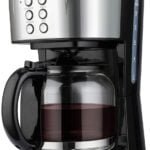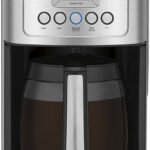With the partaking recognition of various brewing methods, preparing espresso appears simple as you only need primary elements; ground espresso and water. However, it is not that easy as a end result of brewing the proper espresso sometimes requires plenty of work https://cccdp.org.
In the world of espresso brewing, there are tons of components you should understand. One of them is controlling your brew utilizing correct extraction.
The start of learning and mastering your coffee is by having a cautious understanding of coffee extraction basics. Extraction is certainly the most important facet of espresso brewing. It can either make or break the flavour of your coffee. But if you give the trouble to know what it is and how to manipulate it entirely, you can brew the best espresso you presumably can.
Let’s check out this article and additional discover extraction. We included the Coffee Brewing Control Chart to determine the relationship between p.c extraction and complete dissolved solids at a given brewing ratio.
What is Coffee Extraction?
Coffee extraction is a process of extracting soluble compounds from ground coffee. It is solely referred to as brewing espresso since it entails a mixture of ground espresso, water, and time.
But some science goes behind this concept as many reactions occur throughout this course of. In coffee brewing, extraction is required to dissolve these beans’ totally different natural advanced compounds which are developed from roasting.
So, what occurs is that the strong elements of floor espresso are remodeled into liquid. Since the flavors are easily dissolved with sizzling water, this produces a espresso extract. This extract consists of water-soluble compounds that instantly affect the taste and aroma of the espresso.
Extracting the Chemical Compounds
While professionals tend to strategy extraction as chemical analysis, you can begin by simply having related information and understanding its precept.
There are plenty of useful descriptive guides that you should use to gauge your coffee. Wherein the body, aroma, acidity, flavor, and aftertaste are the categories used to outline an excellent espresso. But in extraction, your extracted coffee is predicted to include these essential compounds.
Acids– Acidity is a vibrant sensation that brightens the taste of your espresso. You have to extract the appropriate quantity of it to keep away from a boring and lifeless brew. Acidity is a crucial compound that lifts and completes the total potential of your espresso.
Caffeine– Caffeine is usually recognized as a bitter-tasting stimulant. You additionally must extract this compound to be blended with other ingredients and stability the espresso flavor. Besides contributing to the general style, caffeine is the appropriate compound you want to jump-start your day.
Lipids– The lipid content material of a brewed coffee performs an essential role when perceiving mouthfeel. Coffee and tea are distinctive advanced compounds that make your mouth perceive them weirdly. Lipids are a typical component present in espresso oils, which is a function of the composition of the bean and the circumstances of extraction.
Sugars– A well-balanced extraction tends to ends in a sweeter and more flavorful brew. The sweetness, viscosity of your espresso can also be a vital factor in improving extraction. It is introduced to balance the unpleasant components like bitterness and astringency.
Since the espresso has the body, acidity, flavor, and aroma derived from hundreds of extracted compounds from the roasted beans, it’s important to have relevant data on the means to manipulate the variables that have an effect on extraction.
The Coffee Brewing Control Chart
Coffee professionals and experts extensively use the Brewing Control Chart to gauge their brews. You can also use its graph to grasp the idea of espresso brewing clearly.
For example, what happens if the TDS and PE aren’t within the best region? By looking on the graph, you have already got a baseline for the end result you can expect. You simply need to style the ultimate product to verify the calibration of the espresso.
It’s confusing at first, but it’s price it if you will put the effort to review and perceive it. In the tip, you’ll have the ability to control your brew and have a good cup of coffee.
The management chart beneath may be boiled all the means down to fundamental measurements. Ideally, extraction is conveyed by lots of variables. The brew ratio, extraction proportion, and the ideal level of extraction are the essential measurements that decide the extraction.
Brew Ratio
A espresso to water ratio that creates a espresso that fits your style preference. Your recipe ought to have the proper balance between the amount (by weight) of grounds and the volume of water poured over that floor espresso.
Strength
It is the side of explaining the soluble concentration of your brew. However, remember that sturdy coffee isn’t all the time the results of high extraction, neither the results of a high concentration of caffeine.
In this case, power is technically used to demonstrate the concentration of the extracted soluble compounds inside your brew. Looking at the chart under, the usual optimum share of soluble concentration ranges from 1.2%-1.45%.
Extraction Percentage
The proportion of the dissolved stable particles out of ground espresso tends to be around 18–22%. This is the perfect extraction yield %, in accordance with the Coffee Brewing Institute. Under and beyond these values are often seen as under-extracted and over-extracted.
Total Dissolved Solids (TDS)
TDS is a measurement referring to the calculated number of espresso solids that have been extracted into the water. Using a refractometer, you probably can measure the TDS in your brew and be interpreted in PPM (parts per million).
On the other hand, the TDS% is the espresso solids’ concentration measured in proportion. It signifies the strength of your coffee, ranging from 1-12%, whereas the upper the TDS proportion, the stronger the espresso is.
The energy (TDS) of the brewed espresso is plotted on the vertical axis. The extraction proportion is on the horizontal axis. And lastly, the brew ratio represents those red diagonal traces. The best aim is to get into the ‘Optimum Balance’ area.
While the flavour wheel options dozens of taste attributes, this espresso brewing control chart only points into two particulars, bitter and under-developed.
Under-developed Area– Providing flavors interpreted as bitter or grassy caused by low extraction. That is as a end result of the needed coffee flavor has not been extracted.
Bitter Area– Introducing unpleasant and unfavorable components because of excessive extraction. The espresso has been extracted beyond the beneficial time, making it more bitter.
Optimal Balance Area– It is your best brew, where it has the best steadiness between sweetness, bitterness, and acidity.
Note:Although you might find it relevant in its time, according toSCA, this traditional chart lacks applicability in this modern brewing era. There is a constant shift in consumer preference, new brewing strategies, and elevated demand for distinctive coffee. In this case, it’s challenging to develop this chart higher. Luckily, present analysis is underway to work on updating and increasing the classic Coffee Brewing Chart.
How to Calculate Extraction
Extraction is normally conveyed by extraction (soluble yield) share. Supposed you want to know how many % of espresso (soluble) particles have been dissolved within the water, you can begin by experimenting along with your dosage.
Extraction yield% is computed by dividing the TDS (g) by the Dose of Ground Coffee, then multiplying by 100%.
Extraction yield% = TDS (g) /Dose (g) x 100%.
Let’s take an example. Let’s say out of your dose of 20 grams. A refractometer is used to measure the quantity of Total Dissolved Solids (TDS) in your brew. You ended up with a total of four grams of dissolved solids in your cup from the refractometer studying.
Using the above equation, you probably can calculate the extraction yield, which is 20%. (4g / 20g x 100% = 20%).
You can also use the formula offered by the BaristaInstitute to compute for extraction price or extraction yield. In this case, as mentioned, the TDS % is normally the range for different types of coffees from 1-12 %.
Let’s say you ended up with a complete of 40grams of brewed coffee, having a dose of 20 grams. You want to know the extraction yield% when the refractometer measures a 10% TDS. By using the method, the extraction is 20%. (Extraction Yield% = 40g x 10% / 20g = 20%)
But what if you want to determine on the quantity of floor espresso based on the given chart above? You can use this formulation derived from the above equations.
[Ground espresso (g) = one thousand (TDS) / Extraction + 2(TDS)].
If you want to brew a coffee inside the Optimum Balance space, you may want to have a TDS% of at least 1.25 and extraction% of 20. By doing the math and using the chart as your information, you can easily decide the best dosage before you start brewing, which is approximately fifty five.5g. [Ground espresso = one thousand x 1.25 / (20 + (2(1.25))].
However, in reality, these numbers are just your guide. Aiming for a selected worth doesn’t guarantee the perfect coffee. Since not all coffees are the same, you’ll find a way to nonetheless have a balanced extraction should you focus on the variables that get the best or best share extraction.
How does Extraction Affect Coffee Taste?
You have to extract the flavors, acids, oils, and different elements from the grounds. However, these compounds have totally different mouthfeels and usually are not all dissolved on the same rate.
Some flavors, such because the acidic and fruity notes, are pulled out first as a outcome of water can dissolve quickly. The oils and sugars observe it as they take somewhat extra time to come out. And then, finally, the bitterness is extracted final as a result of it takes an extended time to dissolve. Once you understand this course of, it can lead to getting a balanced extraction.
Controlling the extraction lets you create a espresso that suits your taste preference. However, while its concept is at all times easy, you may still find it more challenging to execute. So, you have to understand the idea of extraction as it’s the most important side of brewing coffee.
Balanced Extraction
This degree of extraction happens when you take note of the crucial variables that contribute to good extraction. Balancing numerous variables permits you to obtain a well extracted, scrumptious coffee. Remember that the sugar ranges, acidity, and bitterness of the brewed coffee are additionally correlated with the extraction percentages, and balancing these compounds requires significant work.
While greater extraction percentages don’t really imply a stronger brew, it positively responds to greater sugar levels in coffee. But in the lengthy run, understanding these aspects help you brew better coffee.
Clarity and Transparency– The readability in your cup tells you what your coffee actually tastes like. It may depend upon many variables, such because the brewing method or kind of bean, in achieving readability and transparency. But general, a balanced extraction additionally gets the flavour you want from espresso.
Sweetness– You know you probably did a great job when you brewed a superb and easy coffee with a fruity and floral flavor that dominates bitterness. That is due to the extracted oils and lipids that provide a good cup of coffee, which leaves you wanting more another sip.
Acidity– A balanced extraction tends to ship a fancy total taste with the proper combination of bitterness, sweetness, and acidity. While acidity is among the most essential components in coffee, too many acids can negatively have an effect on your coffee expertise. It can be either good or unhealthy, mild or heavy in your tummy, depending in your tolerance. But fortunately, proper extraction is likely considered one of the ways to brew much less acidic coffees.
Over-Extraction
Over-extraction happens when too many soluble supplies are extracted out of the bottom espresso. This offers you an terrible coffee style because that unpleasant bitterness and astringency overpower the sweetness and acidity of your espresso.
This level of extraction happens as a outcome of your grounds are too nice and your water is very scorching. The beans which are ground into an especially fine powder have more surface space for water to extract the flavour faster.
Other variables contribute to it, such because the extraction time, strain (in espresso), grind measurement, brewing method, and so forth. But fortunately, we can extract the appropriate quantity of taste to make an enjoyable cup potential by controlling these talked about variables.
Signs Your Coffee is Over-Extracted
According to the baristahustle, three things distinctly indicate over-extraction. If your brew is bitter, drying, and hollow, then you’ve most likely over-extracted your coffee.
Bitterness– Over-extraction results in bitter coffee. While the bitterness in your brew comes from caffeine, more often than not, it is the outcome of improper extraction. If your cup of joe has a dominant style of bitterness, it’s because you extracted a bunch of bitter chemical compounds from your grounds during the brewing process.
That’s not the only aspect that contributes to your coffee’s taste profile. A darker roast, for instance, also influences the notion of bitterness. If you wish to know extra about it, we have written an article on the Reasons why your Coffee Tastes Bitter.
Dry Mouthfeel– Dryness in your espresso is a sign of over-extraction. It is described as an intense sensation that makes your mouth really feel dry. It’s like eating raw fruit or something similar, making you’re feeling like all of the moisture is sucked up throughout your throat.
This sensation lingering in your mouth is called “astringency.” It is attributable to chemical substances answerable for dryness in coffee. It tastes the identical because the aftertaste of unsweetened black tea. The best approach to expertise it’s to grind and brew green espresso.
Empty Flavor– Over-extraction doesn’t solely present overpowering and dominant taste. Too many advanced compounds can remove different flavors and make your espresso simply tastes empty and lifeless in any respect.
For instance, caffeine is a tiny element of your espresso, however it is an important compound figuring out the coffee’s distinctive identity. Over-extracting a variety of parts can weaken the structures of other compounds, resulting in a uninteresting and unexciting coffee.
The incontrovertible truth that coffee has thousands of complicated compounds, these compounds have different chemical bonds and effects. And it’s still difficult to understand their relation and reaction to each other.
An overdosed taste reacts with other elements and produces a model new perception of taste. You can’t obtain the proper balance and consistency and doubtless can’t recognize the best recipe if there are too many flavors in your brew’s composition.
Under-Extraction
On the other hand, under-extraction occurs whenever you haven’t extracted sufficient soluble compounds out of the grounds. Ground coffee has many flavors to supply, however leaving these essentials behind these beans makes an unbalance and undesirable coffee flavors.
This stage of extraction happens in case your grounds are too coarse. You can’t simply extract out the wanted taste out of your espresso. The too coarse grounds also affect how rapidly you could make your self a cup of coffee as this kind of grind consistency takes time to brew. The water can’t dissolve sufficient stuff from the grounds.
Many variables have an effect on under-extraction. Luckily there are some indicators of under-extraction you can use as a guide.
Watery– While the dearth of flavor is usually caused by numerous components similar to water temperature, coffee to water ratio, and so on., weak espresso is primarily the outcomes of under-extraction. Under extracting the flavors from the grounds gives a dull and tasteless espresso. You can’t get pleasure from consuming your favourite drink if it’s incomplete at all. Based on the dialogue above, it’s from an under-developed space.
Sourness– The sweetness and slight bitterness are the things that you simply want in your cup of joe. But if you’re not taking observe of proper extraction, your coffee will have a sour style instead. Sourness is not the best flavor you want in your brew. It is normally outlined by the beans’ freshness, however you can also get it from under-extraction.
Saltiness– You can’t actually taste such as you poured a bunch of salt into your cup, and there should be components contributing to this facet to make sense. However, under-extraction can still provide a salty taste under some circumstances. If you can get a bitter espresso, then it’s possible to have a salty brew as nicely. Acids and salts are typically dissolved faster than sugar, and this salty taste is usually derived from the sourness of your coffee.
Conclusion
There you’ve it! In the top, you have a tough information and a baseline you ought to use to explain how good your espresso is. It’s straightforward to match your brewing method and scrumptious coffee simply by utilizing the principle of coffee extraction and the brewing control chart above.
However, we’ve only mentioned the nice and the unhealthy extraction. Remember that many variables affecting it, such as extraction time, temperature, grind size, and so forth. Give the trouble to discover and experiment with them by adjusting one issue to a different. After all, understanding extraction and different variables contributing to it permit you to brew higher espresso.
Like this Article? You Might Want to Read: 10 Brewing Mistakes that could Potentially Ruin your Coffee




